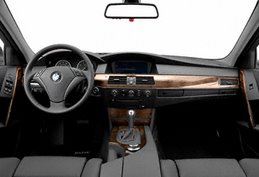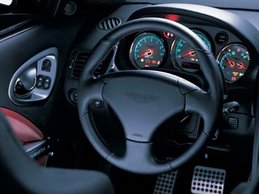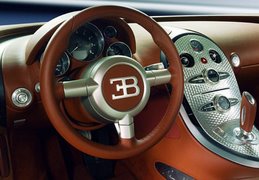 Volkswagen Passat 3.6 - A little mitigation: The big bottom line on our test car's window sticker included the $5550 Package #2 Sport. We're mystified by this, since most of the elements baked into the package—HID headlights, headlight washers, park warning radar, and a super-premium audio upgrade—have nothing to do with sport.
Volkswagen Passat 3.6 - A little mitigation: The big bottom line on our test car's window sticker included the $5550 Package #2 Sport. We're mystified by this, since most of the elements baked into the package—HID headlights, headlight washers, park warning radar, and a super-premium audio upgrade—have nothing to do with sport.We mentioned bigger. The wheelbase stretch is negligible, 106.7 inches versus 106.4; but overall length is up 3.0 inches, to 188.2; width has expanded by an equal amount to 71.7; and at 58.0 inches the new car is almost a half-inch taller. Although these dimensional gains yield a car that's about the same size as a Honda Accord or Toyota Camry, they do add up to a roomier Passat. And inevitably, it adds up to a slightly heavier one.
Which brings us to what's going on under the hood. The short version: more than enough to overcome a little excess mass. VW's new premium Passat engine is a 3.6-liter, 24-valve V-6, replacing the old 2.8-liter V-6 from Audi and the ill-starred 4.0-liter W-8, a technically interesting innovation that tanked in the marketplace. Never mind. The new V-6 will make you forget the W-8, were you inclined to remember it.
The engine sits crossways in its bay—the previous Passat had a longitudinal layout—and it transmits power to the front wheels via a six-speed automatic transmission that includes a Tiptronic paddle-shift manumatic function. We'd rate the action of the Tiptronic as average—manual shifts are deliberate, and the transmission's brain will upshift on its own rather than let the engine bounce off the rev limiter. We'd also call the engine a little too snarly at low speeds, although it does acquire a commanding bark when max power is summoned.
This al so extends to the Passat's dynamics. Although it's hefty, with a typical front-drive forward weight bias—much of the engine's mass rides ahead of the front-axle center line—the Passat is also handier than its more sedate competitors when the pavement gets kinky. The suspension is familiar—struts with lower control arms holding up the front, and a multilink rear—and the tuning, augmented by that stern, Teutonic structure, delivers a sense of authority and certainty that still seems to be unique to cars with autobahn heritage.
so extends to the Passat's dynamics. Although it's hefty, with a typical front-drive forward weight bias—much of the engine's mass rides ahead of the front-axle center line—the Passat is also handier than its more sedate competitors when the pavement gets kinky. The suspension is familiar—struts with lower control arms holding up the front, and a multilink rear—and the tuning, augmented by that stern, Teutonic structure, delivers a sense of authority and certainty that still seems to be unique to cars with autobahn heritage.
This al
 so extends to the Passat's dynamics. Although it's hefty, with a typical front-drive forward weight bias—much of the engine's mass rides ahead of the front-axle center line—the Passat is also handier than its more sedate competitors when the pavement gets kinky. The suspension is familiar—struts with lower control arms holding up the front, and a multilink rear—and the tuning, augmented by that stern, Teutonic structure, delivers a sense of authority and certainty that still seems to be unique to cars with autobahn heritage.
so extends to the Passat's dynamics. Although it's hefty, with a typical front-drive forward weight bias—much of the engine's mass rides ahead of the front-axle center line—the Passat is also handier than its more sedate competitors when the pavement gets kinky. The suspension is familiar—struts with lower control arms holding up the front, and a multilink rear—and the tuning, augmented by that stern, Teutonic structure, delivers a sense of authority and certainty that still seems to be unique to cars with autobahn heritage. Premium accurately describes the Passat's appearance, inside and out. Although some of our Hogback Luddites prefer the simpler look of the previous edition, the new car's sculpted sheetmetal generates a more upscale impression than that of its slab-sided predecessor. Yes, the bigger, bolder grille and logo are reminiscent of the Phaeton—another idea VW's current management would love to be able to forget—but it does reinforce the luxury theme. And if the going-away view looks a lot like a Toyota Corolla, well, when you're terrorizing back roads, you won't have to look at it.
We can't gin up much enthusiasm for the new key-fob ignition lock. You push the fob all the way into the spring-loaded dashboard slot until the car starts, and like all such devices, we're not quite clear on its benefit. But that's where the market is headed, and at least this fob will open the sunroof and/or windows as you head across the parking lot. We also have trouble getting excited about the refrigerated glove box, but it's a big refrigerated
 glove box, in case you need to stash a leftover rack of ribs.
glove box, in case you need to stash a leftover rack of ribs.But for all that, we think the Passat may face an uphill fight for its place in the U.S. mid-size-sedan market. Beyond the noise and suspension-clatter issues, there's that price. The least expensive Passat—VW calls it the Value Edition (read "decontented"), with a 197-hp, 2.0-liter turbo four and six-speed manual transmission—starts at $23,565. That's only about two grand less than a Honda Accord LX with a V-6.
Thanks to the highest production costs of any European carmaker, and the strength of the euro, VW, long the people's car company, is forced to position its offerings at the premium end of their respective segments.













No comments:
Post a Comment